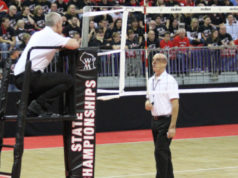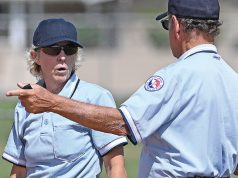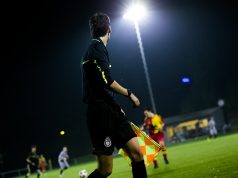When people hear the word “communication,” they think of how one person speaks to another. A sometimes overlooked yet critically important method is body language. In many ways, an official’s body language is just as important as verbal communication. Just like profanity to a player or coach can get an official in trouble, poor body language can escalate a negative situation. Conversely, positive body language helps ease and control a potential conflict.
At all times, stand tall and firm. Use good posture. It will help give an appearance of confidence and possibly reduce the number of conflicts. Hold your head up; don’t dip your chin.
When a player or coach challenges you, consider what your body language says to the arguer and the observers (other players, coaches, fans, etc.). Avoid crossing your arms in front of your chest. That movement appears too aggressive. Also avoid a strong looking “hands-on-hips” stance with your chest thrust out. Again, the official appears the aggressor. When an argument ensues, consider placing your hands behind your back. Stand tall and strong while doing so. That stance does not appear confrontational, yet shows you’re in control. At all times, avoid pointing at a player or coach. Using that gesture appears too aggressive and almost always gets a heated response like, “Get your finger out of my face!” Make solid eye contact during the discussion. If your eyes wander or your head moves around looking elsewhere, it appears you’re either intimidated by the coach or are not interested in what’s being said. Neither is good for the conversation. Also, try hard not to scowl.
From the moment you arrive at the game site, pretend there’s a TV camera pointed directly at you. In effect, you’re on stage. Think about what you would look like if you were on TV and there was no sound.
Here’s a situation where body language impacts a discussion with a coach:
As a high school softball umpire, you call a runner out on a close play at second base. The coach comes out of the dugout and onto the field to ask you about the call. Early in the exchange, the coach is calm and talking in relatively normal tones. The coach simply wants an explanation of the call, saying, “I know you were closer to the play than I was, but it looked to me like my player was in there. What did you see on the play?”
While the coach is talking, you don’t say anything verbally but your body language shows you’re not thrilled with the coach. You fold your arms in front of your chest, have a smirk on your face and then roll your eyes when the coach says, “… It looked to me like my player was in there.”
Watching your body language, the coach becomes agitated and says, “Hey, I’m just out here asking a question and I have a right to do that. I’ve shown you respect and I expect the same from you.” With that, you raise your hand as a stop signal, then wave the coach back to the bench as if dismissing him, all with a cocky smile on your face.
The coach then gets closer to you, stands firm and yells, “You’ve got an attitude problem! You’re not bigger than the game. I’m going to send a report to the high school state office. This is ridiculous! Your attitude stinks!” You then eject the coach.
Through the whole scenario, you didn’t say a single word. Yet your body language screamed at the coach a variety of things, including disrespect, cockiness and an unwillingness to listen. Better body language — eye contact, comfortable stance with hands behind your back, maybe even a “yes” nod to let the coach know you understand the concern — coupled with a solid verbal explanation would have helped you address the coach professionally and avoid a heated argument.
Your whistle or flag
Your whistle and your flag are communication tools. When you blow a weak whistle, you’re more likely to be challenged because it sounds like you’re not sure of yourself. Conversely, a constant, overly loud whistle equates to screaming. There are times when you need a loud whistle (to get a person’s attention, in a loud setting, to help “sell” a call, etc.). But if you’re constantly blowing your whistle as loud as you can, it would be like you’re yelling every time you speak. Blow a strong, steady whistle with normal volume in most situations. Don’t use short, repetitive blasts except possibly to get someone’s attention in a loud setting. Short, repetitive blasts draw unnecessary attention to the official and can be perceived as “sticking it to” the offender. Think of your whistle as an extension of your voice. Most of the time, “talk” with normal tone. If the situation requires you to be a bit louder and firm, blow your whistle a bit harder. Use that tone sparingly.
The same principles apply to football officials throwing a flag. The way you use your flag is a method of communicating. If the flag you throw looks more like it simply fell out of your pocket, it’s a weak flag, suggesting that you’re unsure about what you called. An “angry” flag occurs when an official gets emotional about a call. Slamming the flag into the ground also equates to screaming. It appears the official has lost control and is belittling the offender. Throw the flag with an arc so that it flies gracefully through the air toward the area of the foul. By doing that, it doesn’t look like you’re throwing aggressively at someone.
Similar principles apply for a soccer assistant referee signaling with the flag. If the assistant referee’s flag is raised slowly or at “half mast,” you look unsure of your call. Extend the flag in an even line directly from your shoulder to the tip of the flag.
What's Your Call? Leave a Comment:
Note: This article is archival in nature. Rules, interpretations, mechanics, philosophies and other information may or may not be correct for the current year.
This article is the copyright of ©Referee Enterprises, Inc., and may not be republished in whole or in part online, in print or in any capacity without expressed written permission from Referee. The article is made available for educational use by individuals.


















